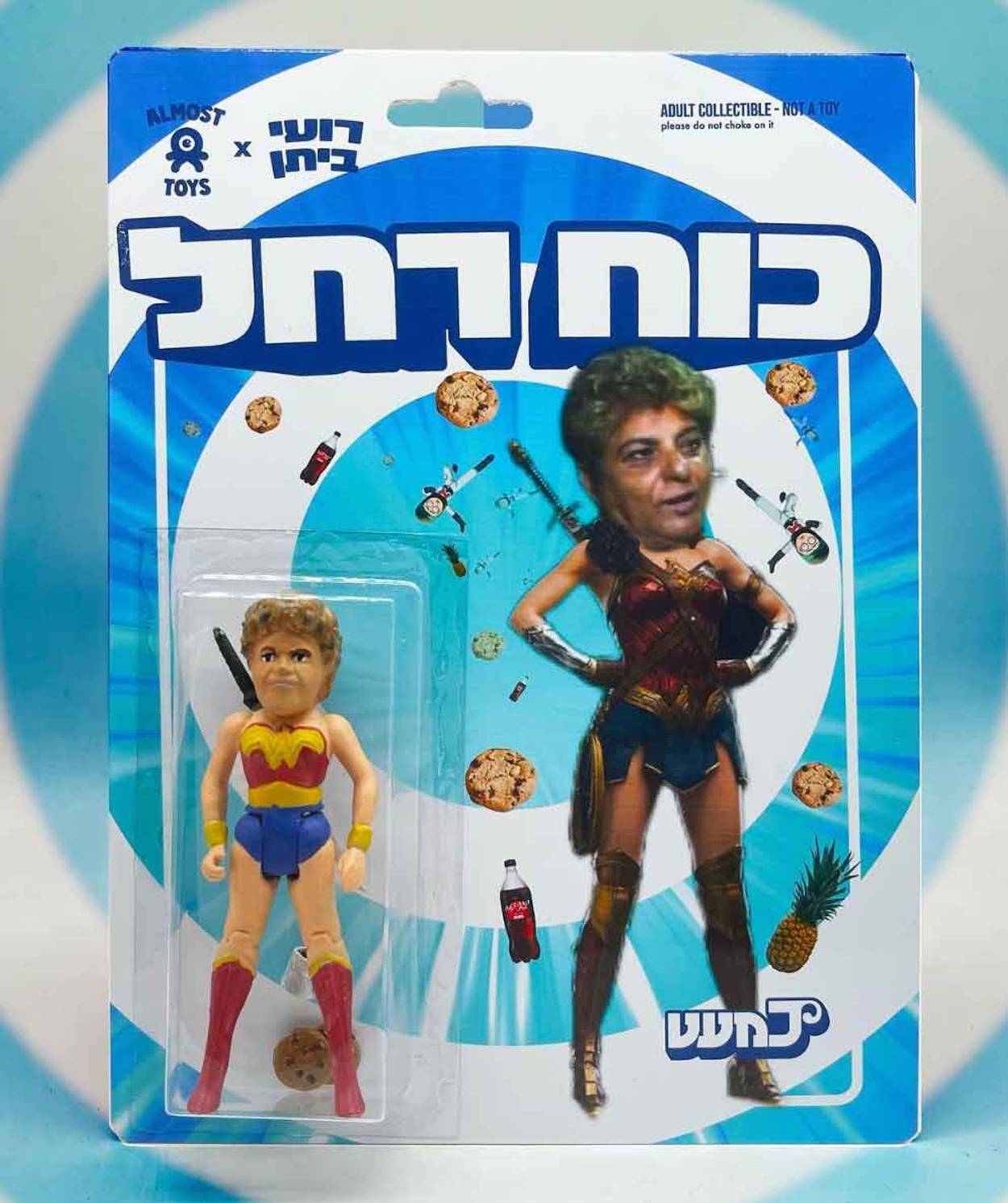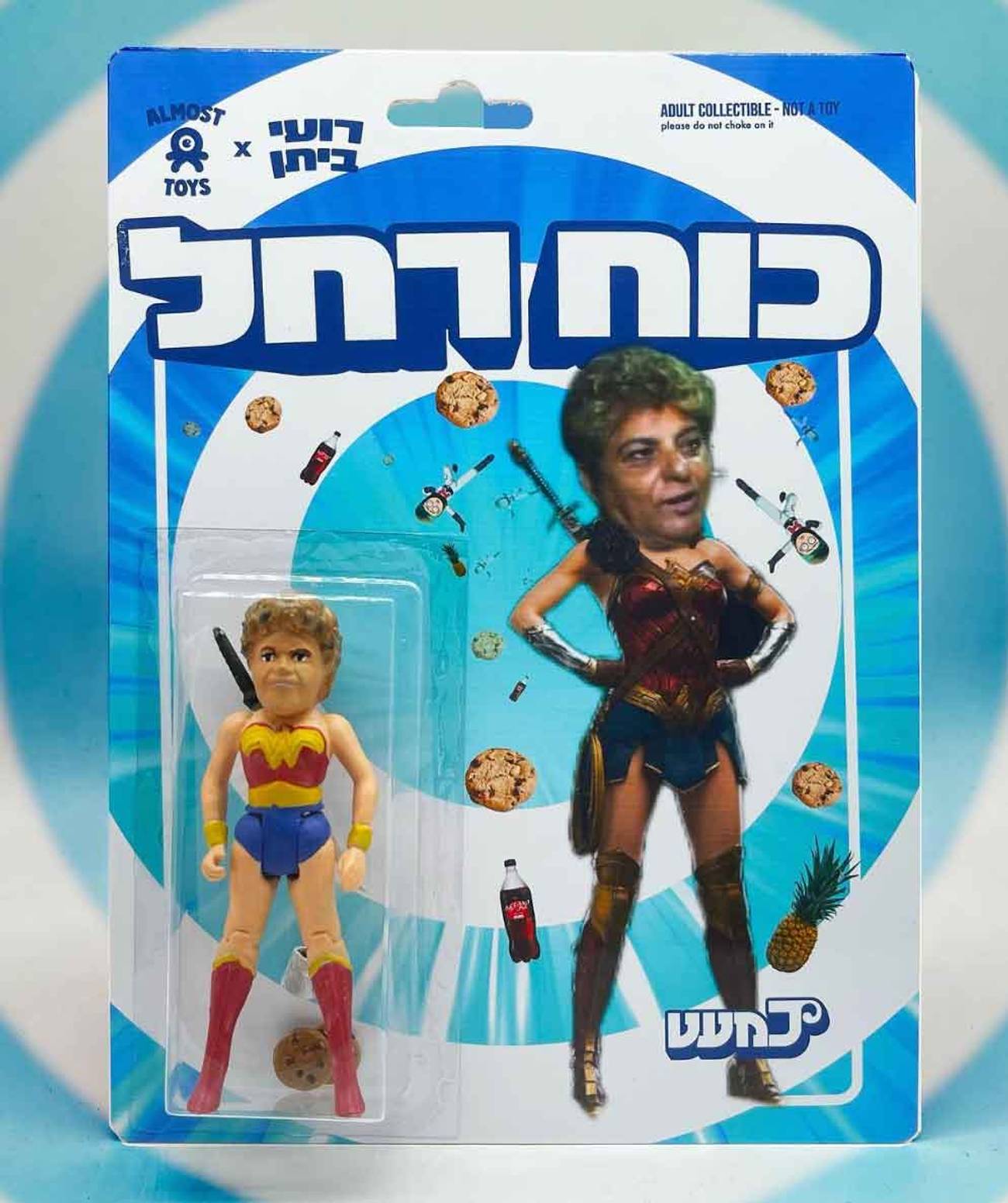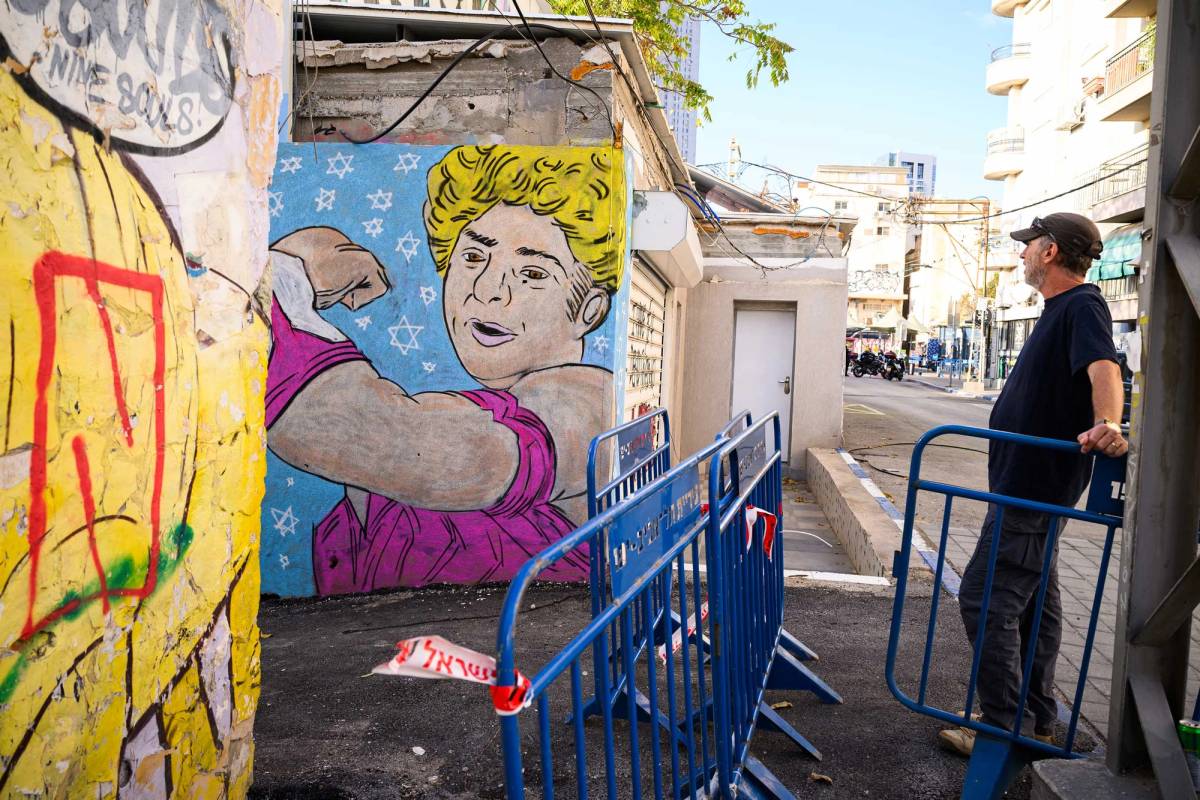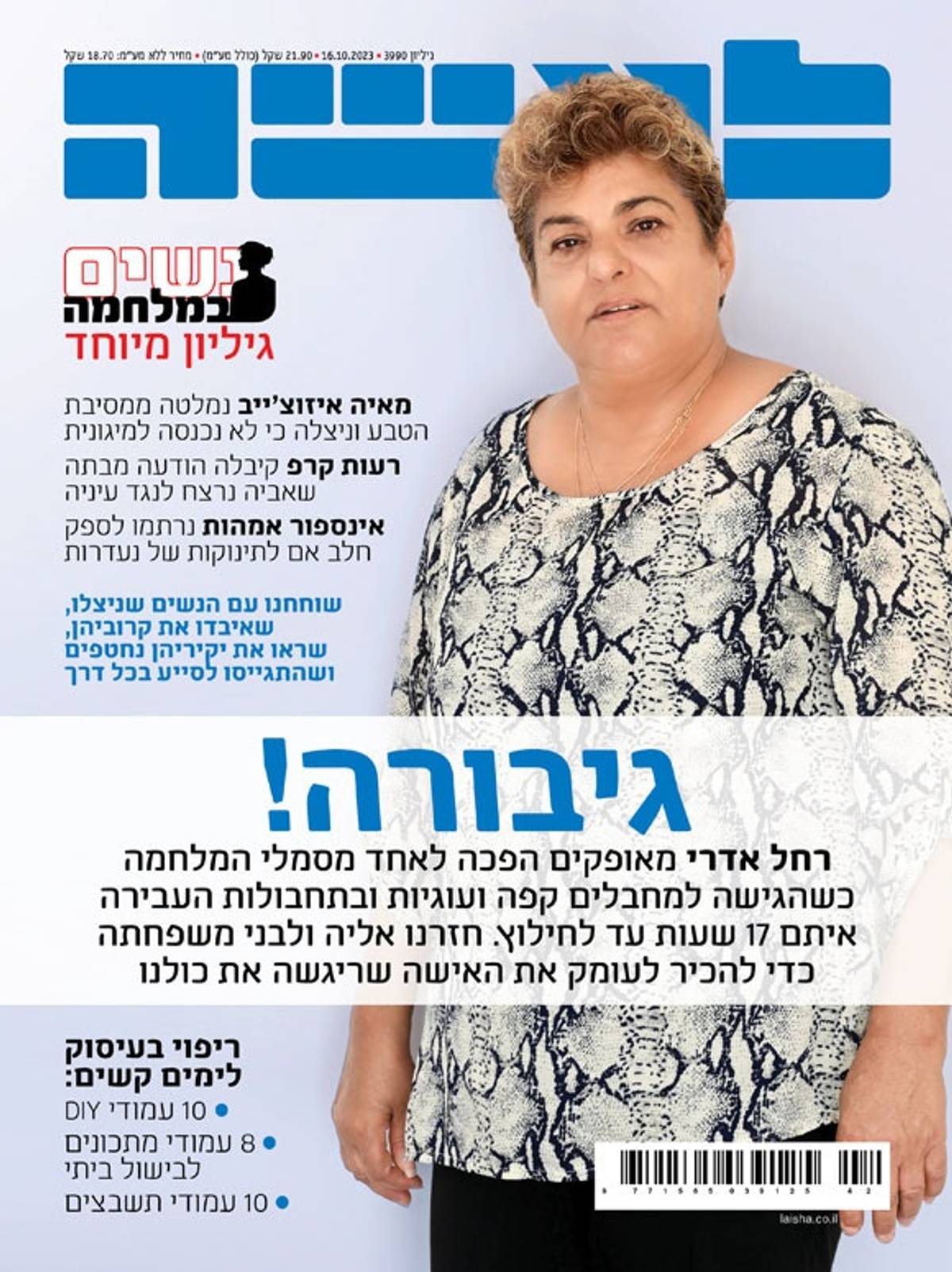From Hostage to Pop Icon
On Oct. 7, Rachel Edri was held hostage by Hamas terrorists. One month later, the Israeli grandmother’s image appears on everything from T-shirts to tattoos, cartoons to TikTok videos.

Courtesy Ori Keinan

Courtesy Ori Keinan

Courtesy Ori Keinan

Courtesy Ori Keinan
One of the best-known stories from the beginning of the Israel-Hamas war is the story of Rachel Edri—the Israeli grandmother from the city of Ofakim in the Southern District of Israel, who was held hostage by five terrorists whom she stalled by cooking for them; giving them cookies, pineapple, Coke Zero, and coffee; and chatting with them until she and her husband were rescued, 19 hours later. The entire world heard of this woman’s level-headedness and resourcefulness, which saved her life. The beautiful and moving narrative of this quintessential Jewish mother, who knows that the best way to keep someone calm is to feed them, was reported on the news; she even got a hug from President Biden.
In Israel, Edri is known simply as “Rachel from Ofakim.” Her persona and her story intertwine humanity with guile and slyness in a way that everybody can relate to. The fact that this courageous woman became a national hero and was made a symbol of this war is not surprising. The interesting part is what happened next: Rachel from Ofakim became a pop icon.

Leon Neal/Getty Image
From Elvis to Frida Kahlo, we are used to seeing pop icons’ faces morphed into pixel art, faux Andy Warhol pop art, caricatures, and anything else that can be printed on physical merchandise or virtually distributed. Usually, to turn into a pop icon, one should be young, talented, charismatic, sexy, good looking—and preferably dead. James Dean, Marilyn Monroe, and Amy Winehouse possessed all of those qualities, while Albert Einstein possessed some. Arguably, Edri possesses none. She turned into a pop icon in her country for different reasons altogether, and she did so faster than most. She did it instantly, before she even had a chance to sweep the terrorists’ cookie crumbs from the floor.
You might think that it’s an exaggeration to call her a pop icon, but it’s not. About a week after Oct. 7, newspaper headlines in Israel announced that Edri signed with the ITM modeling agency, which represents some of the country’s top models, like Eden Fines, Yael Shelbia, and Anna Zak. It’s safe to assume that Edri will be starring in cookie commercials in no time. She also graced the cover of La’Isha, Israel’s leading women’s magazine, which usually depicts models and beauty queens, and was interviewed live on Instagram by pop star Noa Kirel.
Rachel from Ofakim became the subject of countless memes popping up on social media, and was swiftly turned into a character on Eretz Nehederet, Israel’s leading prime-time TV satirical sketch comedy show. Israeli artists, cartoonists, illustrators, and designers started creating Rachel-inspired artwork, while nonprofessionals used AI and Photoshop to generate minivirtual shrines to her. Cartoonist Daniel Amit created a digital illustration of Edri as a Marvel or DC Comics superheroine, while Omer Agam made her into an imaginary Pixar movie poster. Graffiti artist Adi Yonatan Cohen painted a mural of her face on a public wall in Haifa. Illustrator Dana Barlev created a round design that looks like a sticker or an iron-on patch depicting a Kawaii terrorist surrounded by an assortment of cookies and the clever wordplay “I Accept Cookies.”
Musician Roey Bitan created a web series of short animated clips on Instagram that spread to TikTok and YouTube, called Rachel Power. The series reimagines Edri as Wonder Woman, one of the Powerpuff Girls, and various other characters, by superimposing her head on their bodies in little South Park-esque gags. The videos cast Edri as a character in Pokemon or Teenage Mutant Ninja Turtles, or show her with Sesame Street’s Cookie Monster. The series also has a funny theme song, that plays homage to dubbed action cartoon theme songs from the 1980s and ’90s. Consequently, graphic artist Ori Keinan created a one-off Rachel Power collectible action figure as part of his bootleg toy company Almost Toys. Online you can find other Rachel action figure designs as well, which are not real toys but AI-generated designs. Oh, and there is also a Rachel Power online computer game in which the player is Edri and needs to throw cookies at terrorists for points.
Apropos of cookies, the simple fact that Edri’s story is about food struck a chord in the Israeli psyche. From competitive reality TV cooking shows to foodies on Instagram, food is an essential part of today’s popular culture. “Home cooking” in this realm is code for “emotion”—as proven by any reality TV cooking show in which every grandma’s recipe is accompanied by a sob story. This fake emotion gives meaning to life and defeats the masses’ fear of death, and Edri’s homemade cookies evoke something maternal and folkloristic that soothes the soul when mediated through popular culture.
There is also Rachel fashion. Funky T-shirt designers Bootleg Studios created a fun and colorful Rachel T-shirt, which can be purchased from their website. The T-shirt, named “Rachel Our Mother” after the biblical Rachel, was the first in their line of “War-merch,” which is what they call their humorous Israel-Hamas war T-shirt collection. While viral videos, T-shirts, and tattoos cater to youngsters, there is also Rachel-merch for preschoolers: Graphic designer Hen Macabi made her into a Zionist coloring page. This illustration was then turned into a tattoo by tattoo artist Lior Yosefi.
All of this seems unbelievable, but it is the reality in Israel. This, of course, is not the first time that politics or war have been absorbed into mass culture, but this is different. Images of Che Guevara or Lenin started being printed on T-shirts long after their death, and people sporting those T-shirts more often than not know very little of what those people did or what they stand for. It seems that these figures had been emptied of meaning somewhere along the way, enabling them to become hollow pop icons. But with Edri, it happened overnight.
My visceral reaction to all of this was: too soon. And it undeniably is. A woman who endured a horrific experience amid the most traumatic day her country had ever known, and is essentially a war hero, had been introduced—all too quickly—into pop culture. If “the medium is the message,” then memes, TikTok videos, and T-shirts are ultimately memes, TikTok videos, and T-shirts, no matter if Kurt Cobain, Mickey Mouse, or Rachel Edri are depicted in them.

The Rachel from Ofakim craze attests to current day-to-day life in Israel, which is officially referred to as “shigrat milchama,” meaning wartime routine—an oxymoron constructed to keep the country and its economy afloat in a fake business-as-usual illusion. This all seems insane, but we live in an insane time. A time in which popular culture is as strong a force as war. A world in which silly TikTok videos and war atrocities coexist in nauseating proximity.
Since everyone knows what Edri did, for the simple reason that it happened five minutes ago, she hasn’t yet been turned into an empty signifier, like Che or Lenin (and it’s safe to assume her 15 minutes will be up before that will happen), but she had certainly been put in the familiar matrix by emptying her dramatic story of gravitas and transferring it to an imaginary pop world.
Does turning Edri into a caricature trivialize what she endured and what she did? Is this all too vulgar and maybe even disrespectful to all the people who lost their lives and their loved ones in this horrible war? Maybe, and maybe not. The horrific events of Oct. 7 were of biblical proportions, or like an Eastern European pogrom from the early 20th century, from a time and place that didn’t have pop culture. However, in 21st-century Israel, mass culture is king, and it’s the way a large part of the population processes things.
All the Rachel paraphernalia and jokes can be viewed as a means for Israelis to try and integrate the reality of war into their daily lives. Whether it’s as a plush doll, a fridge magnet, or a cellphone cover (three products that as far as I know haven’t been produced yet, but may very well be in the works), Rachel’s image is extremely comforting for people, and they want to see more and more of it. It might be one of the only things in this bleak time that can make online visits to social media a bit less heavy and traumatic. Plus, which fun and casual attire could one wear during their wartime routine, if not a Rachel from Ofakim T-shirt?
Rachel gives Israel hope—hope in the ability to enjoy novelty items, hope in humanity, and hope that the Jews will ultimately outwit their enemies.
Dana Kessler has written for Maariv, Haaretz, Yediot Aharonot, and other Israeli publications. She is based in Tel Aviv.